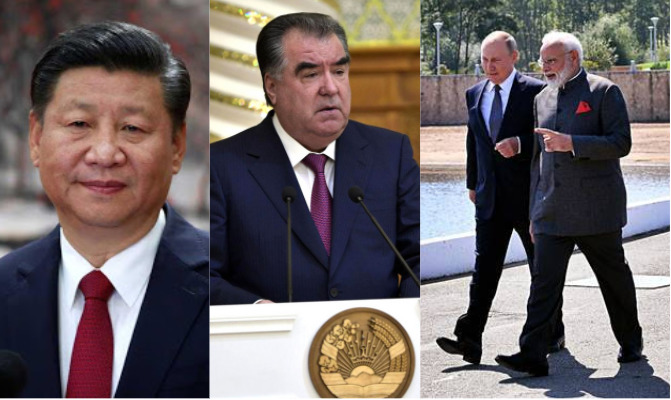While everyone notices China’s salami-slicing tactics in the South China Sea and the Himalayas, the world seems to have missed Chinese expansionism into Tajikistan. So, when China claimed sovereignty over the ‘roof of the world’– Tajikistan’s Pamir region— no one really understood how Tajikistan is becoming the venue of a triangular contest between three big Asian powers: China, India and Russia. And now as Beijing tries to gobble up Tajikistan, it is uniting India and Russia.
China’s growing presence and new military bases in Tajikistan are unsavoury for India because it allows Beijing to jeopardise India’s two biggest geopolitical ambitions- reclaiming its de jure territories of China-occupied Ladakh and PoK. And Russia hates China’s expanding presence in Tajikistan because the Dragon eats into what Moscow considers its exclusive sphere of influence.
Finally, both India and Russia detest the prospect of China entering Afghanistan via Tajikistan. Therefore, India and Russia have found a shared interest in checking China’s expanding footprint in Tajikistan, a strategically located country, situated in between India and China. Tajikistan’s geographical proximity to both Pakistan occupied Kashmir (PoK) and China-occupied Ladakh (called Aksai Chin by China) makes it all the more significant.
Moreover, Tajikistan is also located in close proximity to Afghanistan- a country of considerable interest to India, Russia and China. Therefore, China’s growing footprint in Tajikistan antagonises India’s rebuilding efforts in Afghanistan and Russia’s ambitions to retain its historical interests in the war-ravaged country. Unsurprisingly, Tajikistan is becoming a hotspot of military bases that are expanding just as widely out of the landlocked country as its mountain ranges like the Pamir Mountains, Karakoram and Hindu Kush spread at the junction of the Himalayas.
Russia’s biggest foreign military base– 201st military base– is stationed in Tajikistan and Moscow has been strengthening its military presence in Tajikistan along with other Central Asian Republics. As for India, its first foreign military base is located near Farkhor, Tajikistan. It was established to help the anti-Taliban front, Northern Alliance until Taliban’s ouster in 2001.
Indian Air Force technicians used to service and repair air assets– Mi-17 and Mi-35 helicopters– for several years till 2001. According to HT, technicians from the Aviation Research Centre (ARC)– a wing of India’s external intelligence agency, R&AW– were also involved in service activities at the Farkhor airbase.
In the aftermath of the Taliban’s ouster, India has been using the Farkhor airbase for funnelling economic and relief assistance into the war-ravaged Afghanistan. Therefore, Indo-Russian military cooperation in Tajikistan dates back to the 1990s. The latest entrant in Tajikistan is China, which has not only staked claim over almost half of the Tajik territory but, has also established two military bases near the strategic Wakhan Corridor.
Military presence in Tajikistan serves many purposes for China, the most important among them being increasing its stronghold over Pakistan occupied Kashmir (PoK), creating a fall-back zone in case of an Indian counter-offensive in China-occupied Ladakh, expanding Chinese footprint into Afghanistan and also creating a possible alternative to the China-Pakistan Economic Corridor (CPEC).
China knows that India is going assertive about its two strategically located territories- PoK and China-occupied Ladakh. Last year, India even released a political map showing what China calls Aksai Chin, as a part of India’s de jure territory. PoK and Gilgit-Baltistan too were shown as a part of India’s de jure territory. And then India’s Union Home Minister Amit Shah had announced within the Parliament that PoK and Aksai Chin are India’s integral territories.
Therefore, in 2019, it was reported that China had built a strategically-located military base merely 12 kilometres away from the Wakhan Corridor- a narrow strip of Afghan territory sandwiched between Gilgit-Baltistan (near PoK) and Tajikistan. So, China is killing two birds with one stone- paving way for China’s entry into Afghanistan and also creating a logistics base to challenge India, if and when New Delhi decides to physically reclaim Pakistan occupied Kashmir.
For China, India’s attempt to reclaim PoK can spell a major disaster as it forms a part of the CPEC– an ambitious BRI project to connect China-occupied Xinjiang with the Gwadar port in Pakistan’s Balochistan province. If China loses out on CPEC, then it would mean that Beijing would have to contend with the traditional sea routes via the Strait of Malacca- a narrow stretch of water that serves as a chokepoint in India’s vicinity enabling New Delhi to blockade Chinese trade routes and oil supplies at will.
Therefore, China is trying to build up military presence in Tajikistan as a countermeasure against India. Also, China knows that if it has to build a CPEC alternative due to all the problems associated with the CPEC, the alternative would have to be based in Iran. And for China, it is not possible to reach Iran without accessing Tajikistan and Afghanistan, which is why China is trying to expand its troops’ presence in the Central Asian Republic.
China’s Tajikistan plans are an attempt to weigh down India’s plans to reclaim its territories in the Himalayas. Also, Beijing is trying to kick Russia out of what was once a part of the erstwhile Soviet Union. Therefore, Chinese actions in Tajikistan have created a triangular contest with India and Russia on one side, and China on the other. Away from the entire spotlight, Tajikistan is poised to become one of the world’s biggest geostrategic flashpoints soon.
